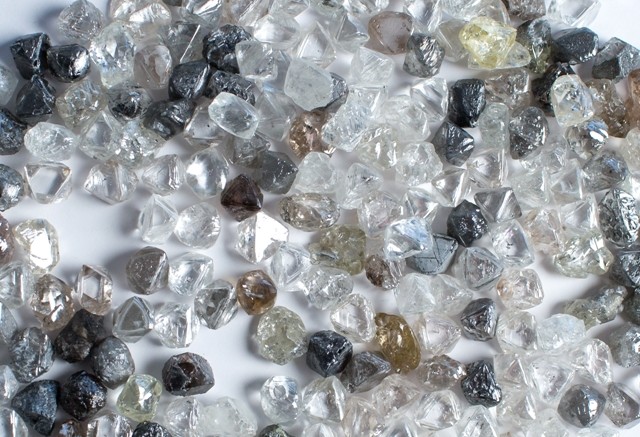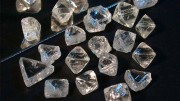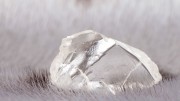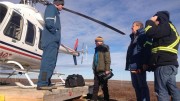Despite a softening in rough diamond prices, Dominion Diamond (TSX: DDC; NYSE: DDC) generated significant free cash flow in fiscal 2015 — paving the way for the company’s first dividend payment since the benefit was suspended in early 2009 due to the financial crisis.
The diamond miner generated US$183 million in free cash flow or free cash flow per share of US$2.15, in the year ended Jan. 31, 2015, compared with US$44 million or US52¢ per share in fiscal 2014.
Profit before income taxes rang in at US$166 million with earnings per share at US78¢, up from last year’s comparable figures of US$23 million and a loss of US27¢ per share. As of Jan. 31, the company held cash and equivalents of US$458 million, an increase over the US$289 million reported at the end of the third quarter.
“We’ve had a good run of late,” Brendan Bell, the company’s acting CEO, told Diamonds in Canada in a telephone interview from his office in Yellowknife in April, adding that the company felt comfortable that a regular annual dividend payment of 40¢ per share was viable.
“No company in this day and age can be blind to the fact that shareholders need to earn a return, and we felt, when we looked at our sources and use of capital, that this dividend was a sustainable and affordable dividend,” he says.
The company paid a dividend of US20¢ per share in fiscal 2009, down from US80¢ in 2008, and US$1 per share in fiscal 2007. Dominion, then known as Aber Diamond, kicked off its dividend policy shortly after acquiring luxury jeweller and iconic retailer Harry Winston Diamond. (Aber paid US$266 million for Harry Winston in two transactions in 2004 and 2006.) The company then changed its name to Dominion Diamond in March 2013.
The new dividend, which equates to a 2.3% yield, should broaden Dominion’s potential investor base and keep it competitive with other yielding diamond producers, such as Lucara Diamond (TSX: LUC) (2.2% regular dividend, 4.4% with estimated specials); Petra Diamonds (LSE: PDL) (1.1% yield); Gem Diamonds (LSE: GEMD) (2.4% yield); and Alrosa (RTS: ALRS) (2.1%), Matthew O’Keefe of Dundee Capital Markets commented in a research note to clients. “Combined with its strengthened balance sheet and attractive growth profile, Dominion offers a good combination of growth and income.”
Dominion expects a lot of that growth will come from the Ekati diamond mine and specifically the undeveloped Jay pipe, which lies beneath Lac du Sauvage, north of Lac de Gras.
In March, the company released an updated National Instrument 43-101 technical report for Ekati, which includes the Jay pipe. Jay is situated in the southeastern corner of the property, about 25 km southeast of the Ekati main camp and mine infrastructure, and about 7 km north-northeast of the Misery Main pipe.
Jay is the most significant undeveloped deposit at Ekati due to its large size and high grade and will add about 11 years of mine life beyond the current projected closure of Ekati in calendar 2020.
Earlier this year, Dominion upgraded the bulk of Jay’s indicated and inferred resource to probable reserves, which now measure 45.6 million tonnes at 1.9 carat per tonne for 84.6 million carats.
“Our process plant handles about 4.3 million tonnes per annum from various different ore sources, and as Jay comes online, it will fill the mill on its own,” Bell says. “With the grade at Jay just under 2 carats per tonne, that gives you a sense of the carat projections.”
Jay prefeasibility
Dominion released results from a prefeasibility study on Jay in January that evaluated the pipe as a standalone, open-pit operation. The study calculated an after-tax internal rate of return of 16% and a post-tax net present value of US$610 million, with total operating costs projected at C$75 per tonne processed.
Initial development costs were tabulated at about US$657 million, of which about US$368 million will be spent on building a dyke and associated infrastructure, including roads and pumps.
Bell says the company is on track to complete a feasibility study on Jay this fall, with engineering work and further optimization studies already under way.
Permitting, he says, can be completed in 2016, with construction starting the same year. Dewatering the area isolated by the dyke and pre-stripping would then begin in 2019, with mining and processing starting from 2020.
Bell says he doesn’t foresee any permitting problems, given the company’s long track record operating Ekati. “We’re into an environmental assessment, which will conclude in early calendar 2016, at which point the minister will give us a go, or a no-go,” he says.
Based on positive feedback so far, Bell believes the environmental assessment will be approved in early 2016. After that, a water licence and land-use permits would take four to six months, with construction starting in the summer or early fall. “That remains the timetable and we are on track.”
To be sure, he concedes, there are always issues through permitting, and it’s important to understand the local and aboriginal community in the Northwest Territories is concerned about any development. “They want to make sure it’s done right, that any negative impacts on the Caribou, or wildlife, or water, are mitigated,” he says.
Bell, who notes that Dominion’s relations with communities are “very strong,” says that concerns about development have to be balanced with the desire for employment.
“We’re the largest private sector employer of people in this part of the world, and those jobs come to a halt in 2019 without Jay, and so people are happy about future employment, but that has to be balanced with minimization of impacts on the ecosystem.”
As Dominion plans for Ekati’s future, it has already made improvements at Ekati’s processing plant that increased the recovered grade of reserve and resource material by about 15% during the fiscal year.
“We’ve been very successful this year at being very diligent and methodical about how we process ore,” Bell says. “We are changing the screens out more frequently to make sure diamonds aren’t missed.”
The focus has been on maximum recovery rather than pushing more tonnage through the mill, he notes.
The company also raised its ownership in Ekati’s Core and Buffer zones by acquiring the interests of Fipke Holdings Ltd.
For the Core zone, which includes the current operating mine and other permitted kimberlite pipes, Dominion increased its ownership by 8.89% to 88.9% for C$55.6 million.
For the Buffer zone, an adjacent area hosting kimberlite pipes having both development and exploration potential such as Jay and Lynx, the company spent $14.3 million to raise its stake by 6.53% to 65.3%.
Diavik
At the nearby Diavik mine, in which Dominion holds a 40% stake, mine operator Rio Tinto (NYSE: RIO; LSE: RIO) announced in November that it has approved the development of the A-21 pipe, which is expected to enter production in late 2018.
At the end of 2014, Diavik had 18.1 million tonnes of proven and probable reserves grading 2.9 carats per tonne for 53.3 million carats of diamonds.
Looking ahead at upcoming capex demands, and with the new dividend in mind, Bell is the first to admit that the company has a lot of investment dollars in front of it.
Dominion’s 40% share of development capex for the A-21 pipe at Diavik, for instance, will cost about C$157 million between calendar 2015-2019.
At Ekati, the company plans to spend about US$27 million in fiscal 2016 on exploration at Jay and US$6 million on exploration at the Sable pipe, about 16 km northeast of the Ekati plant.
Also in fiscal 2016, Dominion plans US$70 million (on a 100% basis) in capital spending on the continued development of the Misery pipe; US$18 million to develop the Pigeon pipe, and US$16 million on the Lynx pipe.
In fiscal 2017, Dominion expects capital costs to be US$38 million at Misery, and US$22 million at Lynx.
That’s in addition to the roughly C$760 million that will be needed for development capital for the Jay pipe between fiscal 2016 and 2020.
To help with its financing requirements, the company entered into a new C$210-million senior secured corporate revolving credit facility with a bank syndicate in April 2015.
Bell says the company doesn’t plan to raise any more capital at this point and should be able to fund its commitments with money coming from Ekati and Diavik.
In Toronto at presstime, Dominion’s shares traded at $22.56 per share within a 52-week range of $12.89-23.
BMO Capital Markets has a target price of $27 per share and describes Dominion as its “top pick in the diamond space,” while Dundee Capital Markets has a target price of $25.
“I think people are starting to be more familiar and more aware of our story,” Bell says. “We are a pure play diamond miner and I don’t have to tell you that many of the other commodities who would compete for investment are somewhat unloved these days; not so with diamonds.”
— Trish Saywell is a senior staff writer with The Northern Miner. This article originally appeared in the May 2015 issue of Diamonds in Canada.






Be the first to comment on "Dominion delivers"